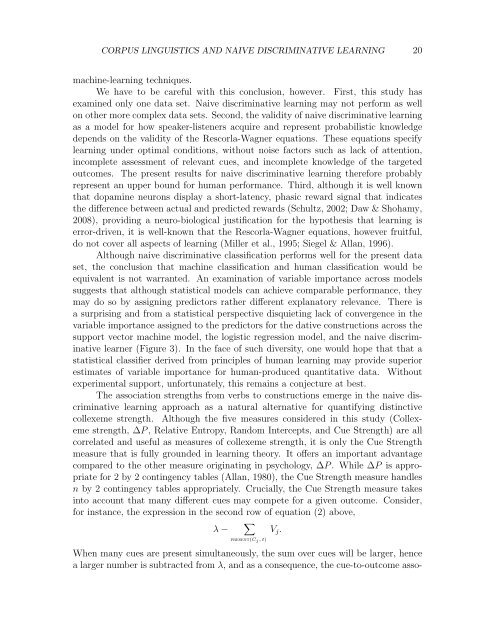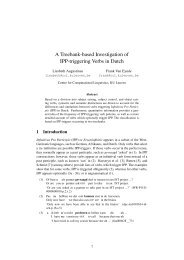Corpus linguistics and naive discriminative learning - University of ...
Corpus linguistics and naive discriminative learning - University of ...
Corpus linguistics and naive discriminative learning - University of ...
You also want an ePaper? Increase the reach of your titles
YUMPU automatically turns print PDFs into web optimized ePapers that Google loves.
CORPUS LINGUISTICS AND NAIVE DISCRIMINATIVE LEARNING 20<br />
machine-<strong>learning</strong> techniques.<br />
We have to be careful with this conclusion, however. First, this study has<br />
examined only one data set. Naive <strong>discriminative</strong> <strong>learning</strong> may not perform as well<br />
on other more complex data sets. Second, the validity <strong>of</strong> <strong>naive</strong> <strong>discriminative</strong> <strong>learning</strong><br />
as a model for how speaker-listeners acquire <strong>and</strong> represent probabilistic knowledge<br />
depends on the validity <strong>of</strong> the Rescorla-Wagner equations. These equations specify<br />
<strong>learning</strong> under optimal conditions, without noise factors such as lack <strong>of</strong> attention,<br />
incomplete assessment <strong>of</strong> relevant cues, <strong>and</strong> incomplete knowledge <strong>of</strong> the targeted<br />
outcomes. The present results for <strong>naive</strong> <strong>discriminative</strong> <strong>learning</strong> therefore probably<br />
represent an upper bound for human performance. Third, although it is well known<br />
that dopamine neurons display a short-latency, phasic reward signal that indicates<br />
the difference between actual <strong>and</strong> predicted rewards (Schultz, 2002; Daw & Shohamy,<br />
2008), providing a neuro-biological justification for the hypothesis that <strong>learning</strong> is<br />
error-driven, it is well-known that the Rescorla-Wagner equations, however fruitful,<br />
do not cover all aspects <strong>of</strong> <strong>learning</strong> (Miller et al., 1995; Siegel & Allan, 1996).<br />
Although <strong>naive</strong> <strong>discriminative</strong> classification performs well for the present data<br />
set, the conclusion that machine classification <strong>and</strong> human classification would be<br />
equivalent is not warranted. An examination <strong>of</strong> variable importance across models<br />
suggests that although statistical models can achieve comparable performance, they<br />
may do so by assigning predictors rather different explanatory relevance. There is<br />
a surprising <strong>and</strong> from a statistical perspective disquieting lack <strong>of</strong> convergence in the<br />
variable importance assigned to the predictors for the dative constructions across the<br />
support vector machine model, the logistic regression model, <strong>and</strong> the <strong>naive</strong> <strong>discriminative</strong><br />
learner (Figure 3). In the face <strong>of</strong> such diversity, one would hope that that a<br />
statistical classifier derived from principles <strong>of</strong> human <strong>learning</strong> may provide superior<br />
estimates <strong>of</strong> variable importance for human-produced quantitative data. Without<br />
experimental support, unfortunately, this remains a conjecture at best.<br />
The association strengths from verbs to constructions emerge in the <strong>naive</strong> <strong>discriminative</strong><br />
<strong>learning</strong> approach as a natural alternative for quantifying distinctive<br />
collexeme strength. Although the five measures considered in this study (Collexeme<br />
strength, ∆P , Relative Entropy, R<strong>and</strong>om Intercepts, <strong>and</strong> Cue Strength) are all<br />
correlated <strong>and</strong> useful as measures <strong>of</strong> collexeme strength, it is only the Cue Strength<br />
measure that is fully grounded in <strong>learning</strong> theory. It <strong>of</strong>fers an important advantage<br />
compared to the other measure originating in psychology, ∆P . While ∆P is appropriate<br />
for 2 by 2 contingency tables (Allan, 1980), the Cue Strength measure h<strong>and</strong>les<br />
n by 2 contingency tables appropriately. Crucially, the Cue Strength measure takes<br />
into account that many different cues may compete for a given outcome. Consider,<br />
for instance, the expression in the second row <strong>of</strong> equation (2) above,<br />
∑<br />
λ − V j .<br />
present(C j , t)<br />
When many cues are present simultaneously, the sum over cues will be larger, hence<br />
a larger number is subtracted from λ, <strong>and</strong> as a consequence, the cue-to-outcome asso-
















